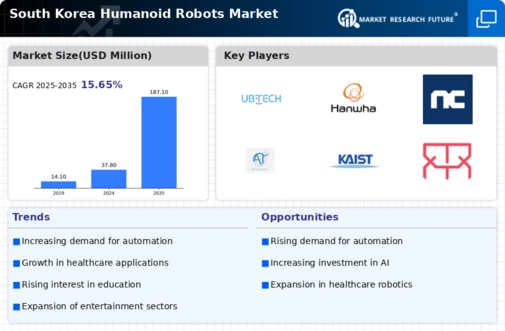The South Korea Humanoid Robots Market is rapidly evolving, driven by advancements in technology and increasing demand for automation across various sectors. As the market grows, competition intensifies among key players aiming to establish a substantial presence. Companies are engaged in aggressive research and development, striving to produce innovative humanoid robots that cater to diverse applications, including healthcare, education, entertainment, and hospitality. This competitive landscape is marked by partnerships, collaborations, and strategic investments aimed at harnessing the potential of artificial intelligence and robotics.
The push towards smarter, more interactive humanoid robots is reshaping business models and driving companies to differentiate themselves through unique offerings and superior performance.Korean Institute of Robotics and Technology plays a pivotal role in the South Korea humanoid robots landscape, contributing significantly to research, innovation, and talent development within the sector. The institute is recognized for its state-of-the-art facilities and highly skilled workforce, which facilitate advanced robotics research and development. With a focus on creating highly functional humanoid robots, the organization channels its expertise into improving the capabilities of these machines, making them more efficient and user-friendly.
As an influential entity, Korean Institute of Robotics and Technology fosters collaboration with industries, contributing to the local ecosystem by promoting technology transfer and innovation.
Its commitment to developing globally competitive humanoid robotics has positioned it as a formidable player in the South Korean market, influencing trends and setting benchmarks for quality.LG Electronics has emerged as a significant player in the South Korea humanoid robots market, driven by its mission to enhance human life through innovative technology. The company is recognized for its smart automation solutions, integrating advanced robotics with artificial intelligence to create robots that enhance daily life. LG Electronics has been developing various humanoid robots aimed at sectors such as healthcare, where its robots can assist with patient care and rehabilitation.
The company leverages its extensive research and development capabilities to continually innovate and expand its offerings. Through strategic mergers and acquisitions, LG has bolstered its position in the market, acquiring companies that specialize in robotics and AI technologies. This forward-thinking approach not only enhances LG Electronics’ product portfolio but also enables it to maintain a competitive edge in the rapidly advancing landscape of humanoid robotics within South Korea.

















